Butternut squash is one of the gifts that fall brings. It is delicious when baked, made into a soup or puree, added to goulash, or used to prepare sweets and treats. But while this tasty, rustic addition to any dish is packed full of vitamins, can it also be stored for later use? Yes, of course!
So, how do you freeze butternut squash?
You can freeze butternut squash when it’s raw or cooked. Whether a delicious soup, the perfect puree, or simply cubed, whichever way you want it, it is completely up to you.
Do you want to know how to freeze squash in numerous ways? Or maybe you’re wondering how long you can store squash in the freezer. Keep reading to learn more about freezing butternut squash.
Table of Contents
What You Should Know About Butternut Squash
Butternut Squash: Basic Facts
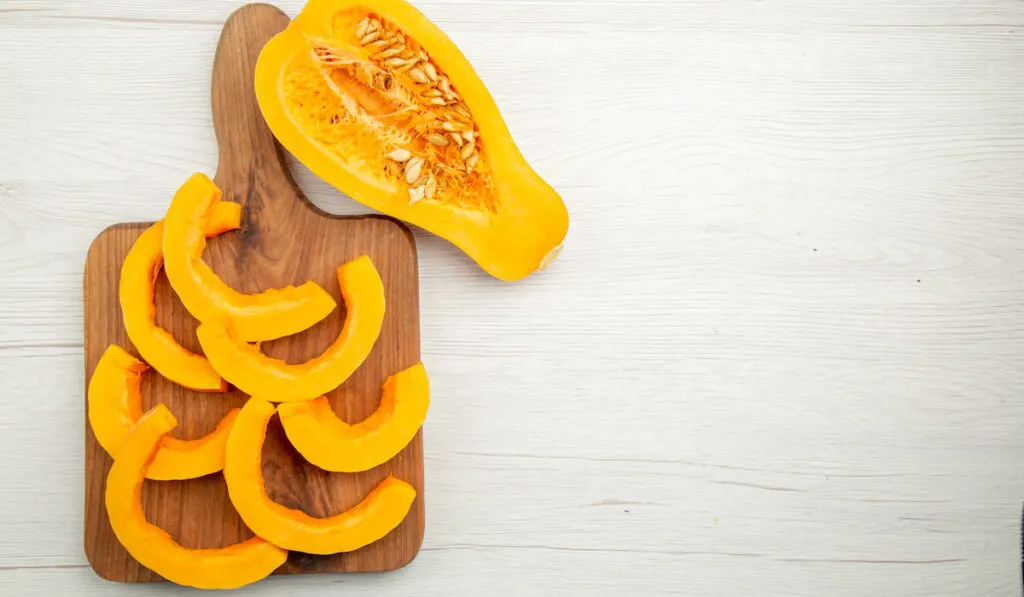
Butternut squash is a medium-sized winter veggie that is cultivated as an annual on a vine. With the shape of an oversized pear, a smooth and creamy mouthwatering texture is revealed when you remove its thick, yellowish-orange skin.
Butternut squash can be baked, pureed into a cream, or included in a stew or soup alongside meat, potatoes, or rice. Those with a sweet tooth can also use it as a seasoning on baked goods. There are a plethora of potential uses to consider.
Because its skin is so thick, butternut squash can be stored for a long time, even all winter.
Frozen squash, on the other hand, makes perfect sense. In addition to providing safe, long-term storage, free from bacteria and rot, freezing the squash also preserves its vibrant color and rich flavor.
However, before consuming any butternut squash, check if it is safe to eat.
Knowing how to identify a good squash from a bad one can prevent you from ruining a meal or, worse, getting sick from food poisoning.
Butternut Squash: Nutritional Value and Health Benefits
In addition to its mild flavor, butternut squash is a healthy veggie, full of antioxidants and vitamins that are good for you. Squash is a fantastic option for those who want to reduce weight, due to its high fiber content and low calories.
The USDA’s National Nutrient Database lists the following nutrients for 205 grams (1 cup) of cooked butternut squash:
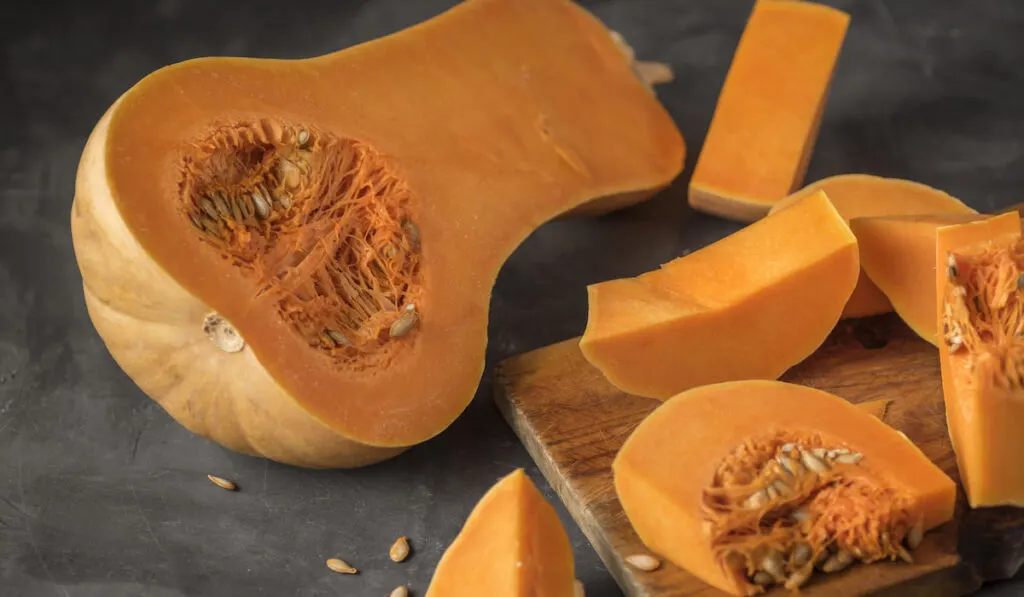
Nutritional Value of Butternut Squash
- 82 calories
- 0.18 grams of fat
- 1.8 grams of protein
- 21.50 grams of carbohydrate
- 84 milligrams of calcium
- 1.23 milligrams of iron
- 582 milligrams of potassium
- 59 milligrams of magnesium
- 55 milligrams of phosphorus
- 31 milligrams of vitamin C
- 1144 micrograms of vitamin A
Health Benefits of Butternut Squash
- Improves digestion
- Boosts weight-loss efforts
- Aids in preventing obesity
- Protects against the development of chronic diseases
- Increases the body’s resistance by bolstering your immune system
- It may help bring down blood pressure
- Protection against diabetes risk
- Benefits to skin health
- Potentially beneficial to eye health
- Potential bone-health promoter
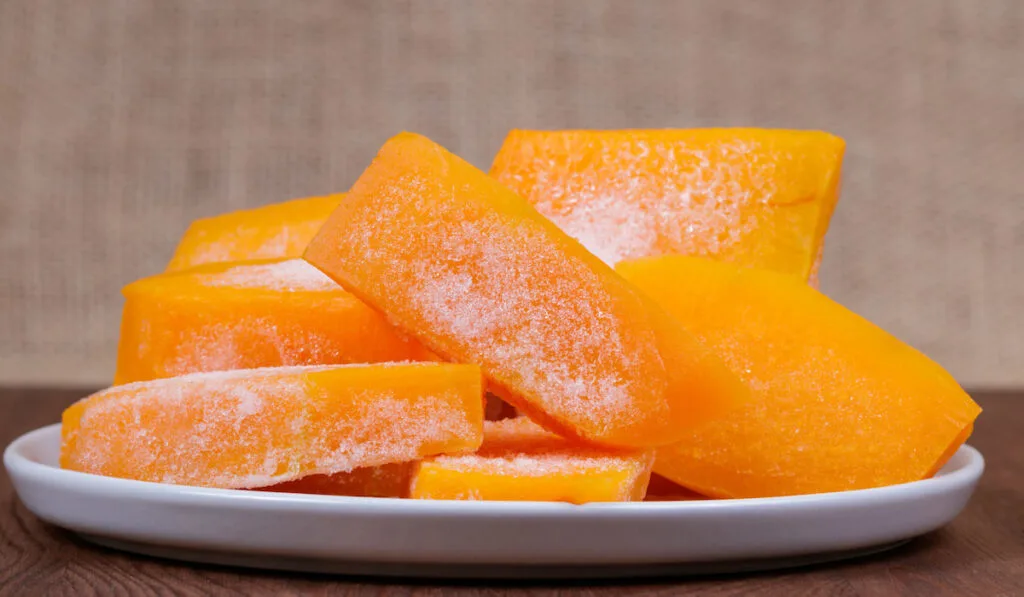
What Are the Benefits of Freezing Butternut Squash?
- Freezing is a great way to keep the unique flavors from a season for longer.
- It also helps save money and stock. A butternut squash can be kept in the fridge for about 5 to 7 days after peeling or chopping before it goes bad. So, due to freezing, extra food does not have to go to waste.
- The low temperature prevents the growth of microorganisms without losing the vegetable’s nutritional properties
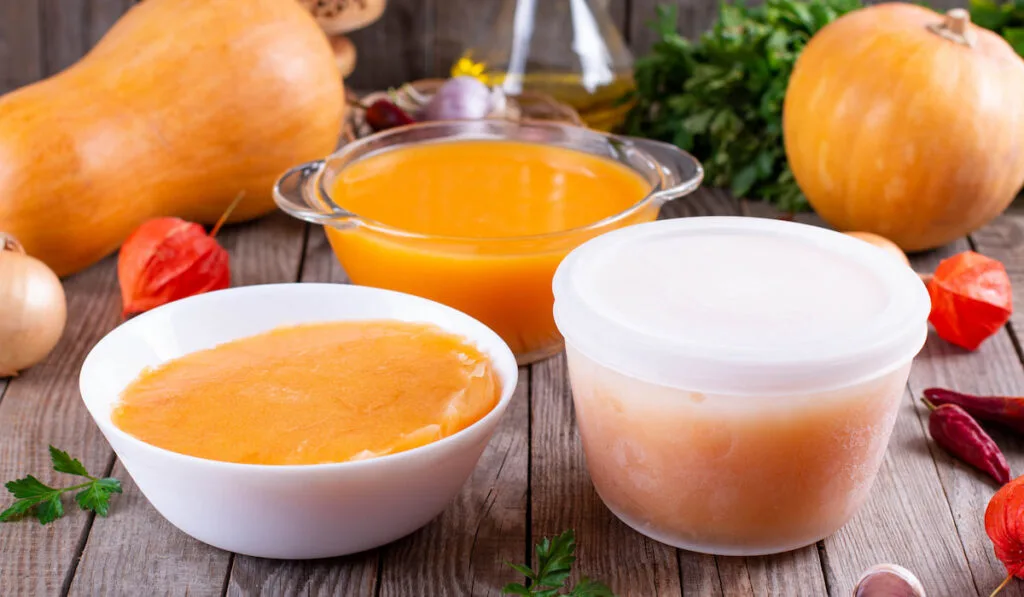
Freezing Butternut Squash – Where to Start?
- Select a butternut squash free of visible skin damage and with dry, rigid stalks. Smooth, unblemished skin and a dried stalk reduce the risk of rot.
- Wash and dry it thoroughly, then remove the skin and seeds.
- Butternut squash can be stored in the freezer in air-tight containers or freezer bags.
- Freezer bags need to be closed tightly, removing excess air.
- A food vacuum sealer is a good investment if you intend to freeze large quantities of food. Products stored in vacuum bags take up less space in the freezer, and their shelf life is greatly prolonged with zero exposure to the air and germs that can spoil foods.
- When freezing squash in various shapes and at various times, it’s important to remember to use labels to add the date and, in some cases, the weight and a description of what’s inside the package.
- There are two ways to freeze butternut squash: raw or cooked. The choice depends on what you plan to do with it afterward.
How to Freeze Raw Butternut Squash
Butternut squash, while raw, can be chopped or grated, depending on how you intend to use it later. Grated squash is a tasty ingredient for pastries, sauces, and soups, while diced squash is fantastic for stew, pasta, or goulash.
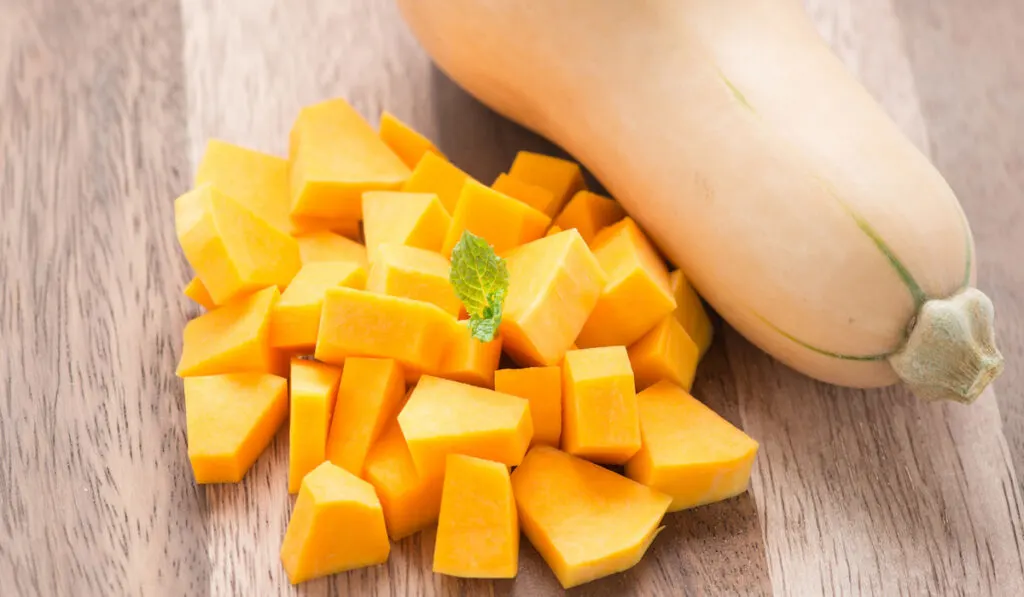
How to Freeze Butternut Squash Pieces or Shreds
- Slice your butternut squash or use the largest holes of a grater.
- If you plan on storing butternut squash for several months, dry them beforehand. Why? You will eliminate extra moisture, allowing butternut squash to last longer in the freezer, and the meals you prepare with it will have a superior texture.
- If you choose to cut the squash in pieces, it’s a good idea to plan their approximate sizes. Remember, parts of squash that are too small will break down during heat treatment. I recommend that they be about 1-2 inches long.
- Put all the squash cubes on the tray and keep them separated from each other. Then put the tray in the freezer until the pieces are frozen. This way, the cubes will freeze separately and not stick together when put into bags or containers.
- The next step is to put the squash into freezer-safe plastic bags or containers.
- Avoid overstuffing bags or containers you use when storing pumpkins in cube form. Do not fill it to the limit because the cubes will stick together.
- Always lay your bags flat to help their weight be spread out more evenly. The freezing process will work better, and the squash cubes will be less sticky if they are in a bag.
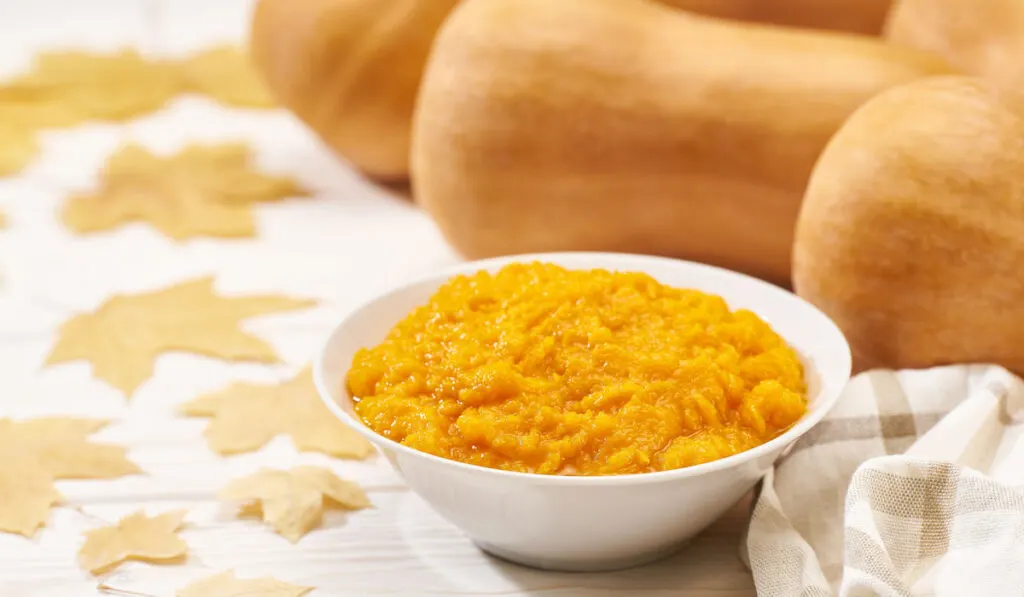
How to Freeze Cooked Butternut Squash
How to Freeze Butternut Squash Puree
- To start, wash the squash and cut it in half lengthwise. Take all of the seeds and soft pulp out with a spoon.
- Place the cut side of the butternut squash on a baking sheet. Line the tray with baking paper and lightly grease it with olive oil.
- Put the squash in the oven at 375°F (190.5°C) and bake until it is soft. The baking time will differ depending on the size of your squash.
- Stick a fork in the squash to see if it is ready. If the fork goes nicely through the pulp of the butternut squash, it is ready to be taken out.
- Allow the squash to cool completely after removing them from the oven.
- Then toss it into a blender, or mash it with a potato masher. Your goal is to create a puree with a smooth, velvety texture.
- You can improve the texture of your dishes and preserve the puree for longer in the freezer if you drain off the excess juice beforehand. Put the puree in a strainer with a fine mesh and let it sit in the fridge for at least an hour.
- Then you just need to put the puree in containers or freezer bags. Don’t forget to lay bags flat to evenly distribute the weight while in the freezer.
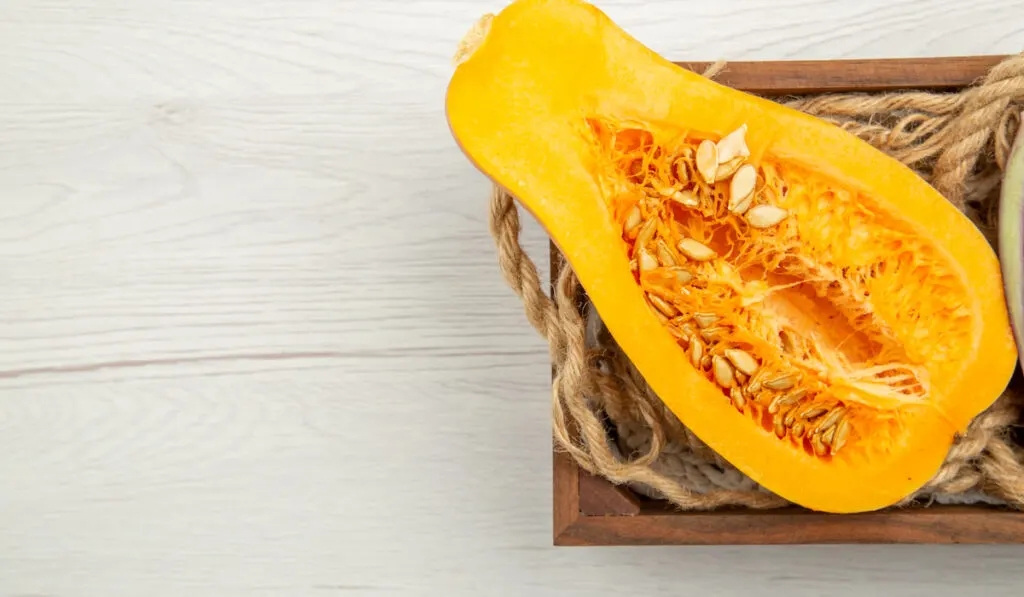
How Long Can Butternut Squash Be Kept Frozen?
Opinions differ, but three months is generally a safe limit for butternut squash stored in the freezer. Others, however, argue that ten to twelve months is acceptable.
Actually, the butternut squash’s storage life depends on what shape you store it in and whether you freeze it raw or cooked (as cubes or as a puree).
Raw butternut squash cubes that have been frozen last the longest, even up to a year. However, one should keep cooked squash frozen for three months at most.
Butternut Squash Defrosting
There are two primary choices for defrosting butternut squash. You can defrost your butternut squash overnight by moving it from the freezer to the fridge. Or, if your microwave has a defrost setting, that’s the quickest option.
What’s the Best Way to Freeze Butternut Squash?
To preserve it for as long as possible, cutting raw butternut squash into cubes before freezing is the best option.
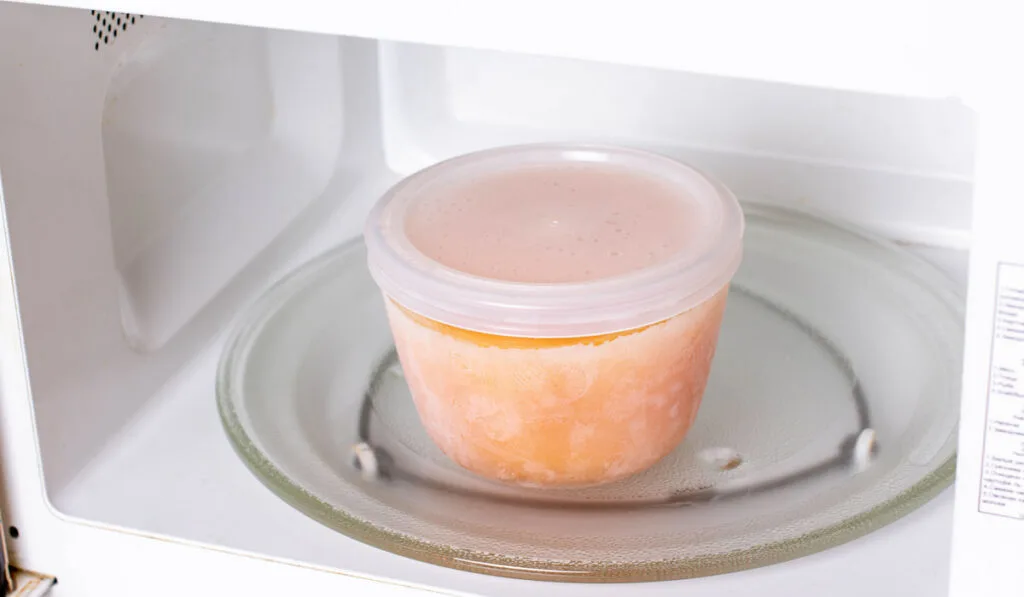
Can I Freeze Butternut Squash Soup?
Yes, the butternut squash soup freezes quite well. So, if you cannot finish your soup, simply freeze it for later use. To freeze, transfer the soup to an airtight container and freeze it for up to 3 months.
Final Thoughts
A full butternut squash with its skin intact can be stored for months in a dry, dark, cool environment, such as a cellar. However, when the skin is removed, storage in the freezer can help extend its life span even further.
Butternut squash can be frozen in raw pieces or as a cooked puree. When frozen, its taste and nutritional content are preserved, so your squash is ready for use in your favorite dishes for months to come!
Resources
Some of the information in this article is from my own experience.
- https://extension.usu.edu/preserve-the-harvest/research/summer-squash.pdf
- https://www.verywellfit.com/winter-squash-nutrition-facts-calories-and-health-benefit-4117503#citation-1
- https://fdc.nal.usda.gov/fdc-app.html#/food-details/169296/nutrients
- https://tools.myfooddata.com/nutrition-facts/169296/wt1
- https://www.bbcgoodfood.com/howto/guide/health-benefits-butternut-squash
- https://www.loveandoliveoil.com/2015/11/kitchen-basics-making-and-freezing-homemade-squash-puree.html
- https://www.epicgardening.com/how-to-store-squash/
- https://bzice.com/can-you-freeze-butternut-squash/
